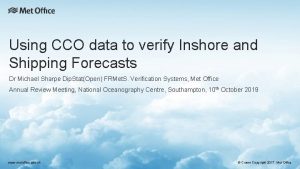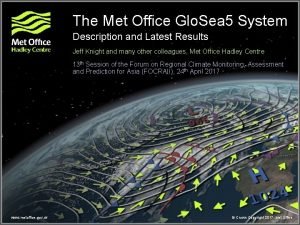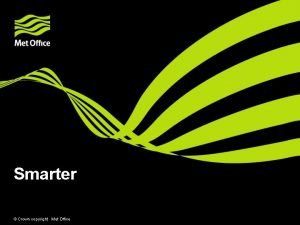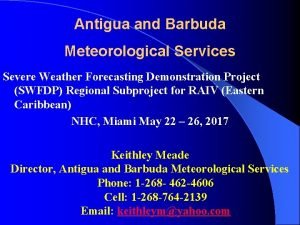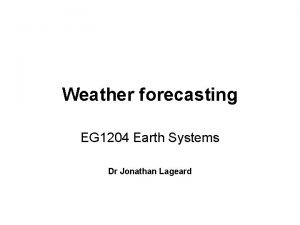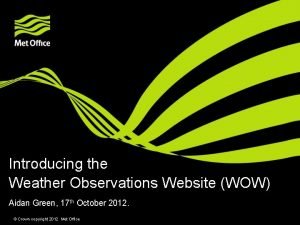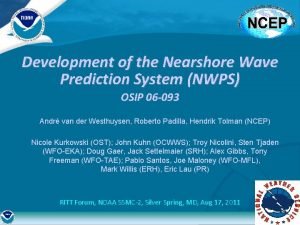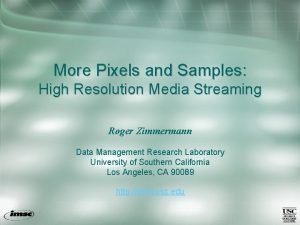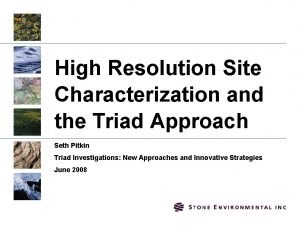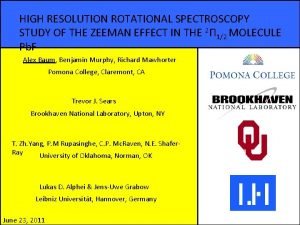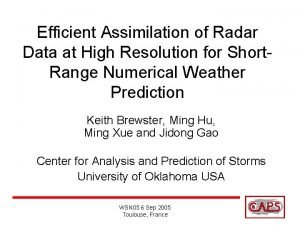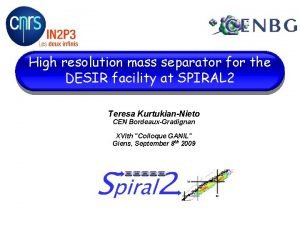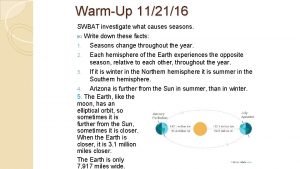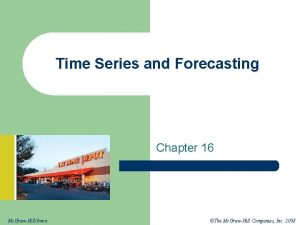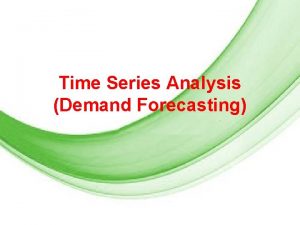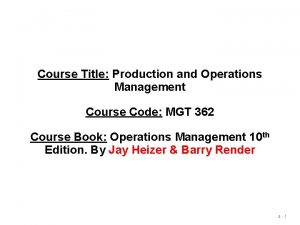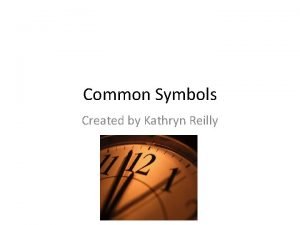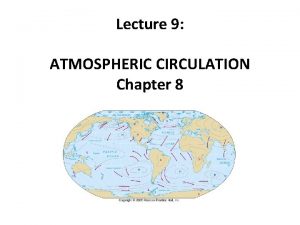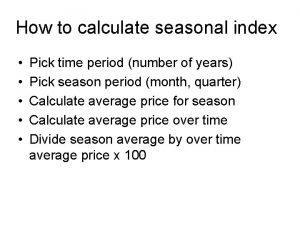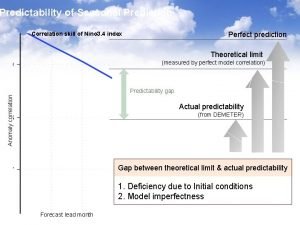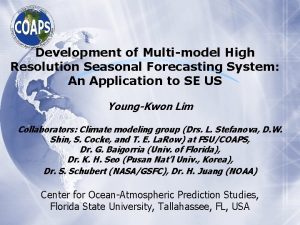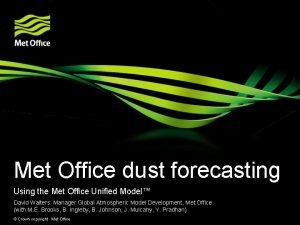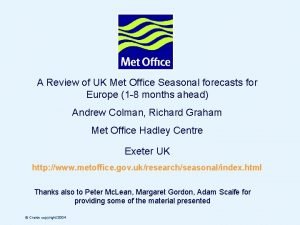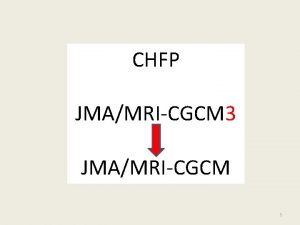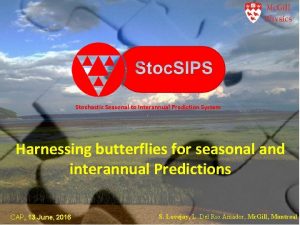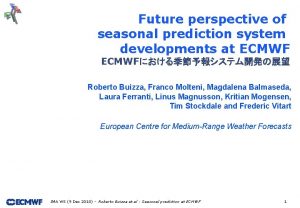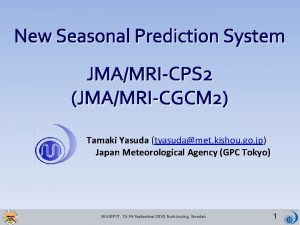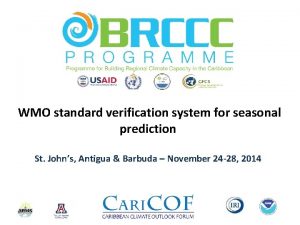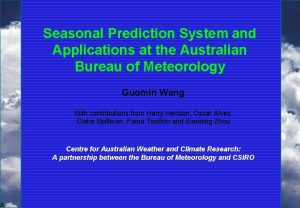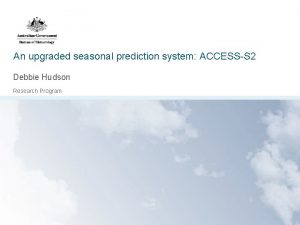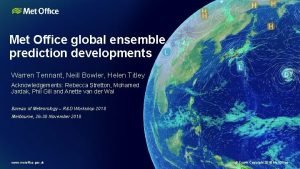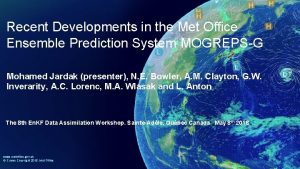The Met Office high resolution seasonal prediction system

































- Slides: 33

The Met Office high resolution seasonal prediction system Anca Brookshaw – Monthly to Decadal Variability and Prediction, Met Office Hadley Centre, UK FOCRAII 2013 © Crown copyright Met Office

Outline • configuration of latest operational system • analysis of hindcasts • ENSO • (N)AO • WNPSH • rainfall ‘extremes’ • tropical storms © Crown copyright Met Office

Outline • configuration of latest operational system • analysis of hindcasts • ENSO • (N)AO • WNPSH • rainfall ‘extremes’ • tropical storms © Crown copyright Met Office

A recent history of improvements at the Met Office - Summer 2009: New generation prediction system (linked to model development) becomes operational - Nov. 2010: - Vertical high-res (L 85 stratosphere / L 75 ocean) - Sea-ice assimilation - May 2011: - Extension to monthly system - Nov. 2012: - Horizontal high resolution (50 km atm / 0. 25 ocean) - NEMOVAR – 3 d-Var ocean data assimilation © Crown copyright Met Office

Representation of orography ~ 120 km ~ 50 km © Crown copyright Met Office

Glo. Sea 5 operational system Model version: Had. GEM 3 GA 3. 0 Resolution: N 216 L 85 O(. 25)L 75 (~50 km atm. ) Simulations length: 7 months Model uncertainties represented by: • SKEB 2 stochastic physics (Tennant et al. 2011) Initial conditions uncertainties represented by: • Lagged ensemble

Initialisation of the system Forecast (initialised daily): - Atmosphere & land surf: Met Office NWP analysis (4 d-Var) - Ocean & sea-ice: NEMOVAR (3 d-Var joint system for ocean, med-range, monthly and seasonal) 14 -year hindcast (1996 -2009): - Atmosphere & land surf: ERA-interim - Ocean & sea-ice: seasonal ODA reanalysis - Fixed start dates of 1 st, 9 th, 17 th, 25 th of each month - 3 members per start date © Crown copyright Met Office

Ensemble: lagged approach Seasonal Forecast: - 2 members run each day. - Seasonal forecast updated weekly by pulling together last 3 weeks (i. e. 42 members) Monthly Forecast: - 2 additional members run each day. - Monthly Forecast updated daily by pulling together last 7 days (i. e. 28 members) Hindcast (for monthly-seasonal): 14 year hindcast run in real time ( 42 members run each week = 14 years x 3 members) © Crown copyright Met Office

How the system runs – an example Atmos & land surf: NWP anal 20/06/2011 21/06/2011 26/06/2011 Monday Tuesday Sunday Ocean/sea-ice: Seasonal ODA Atmos & land surf: ERA-i Ocean: Seasonal ODA reanalysis 25/07/1996 (m 1) 25/07/2002 (m 1) 25/07/2004 (m 3) 25/07/1997 (m 1) 25/07/2003 (m 1) 25/07/2005 (m 3) 25/07/1998 (m 1) 25/07/2004 (m 1) 25/07/2006 (m 3) 25/07/1999 (m 1) 25/07/2005 (m 1) 25/07/2007 (m 3) 25/07/2000 (m 1) 25/07/2006 (m 1) 25/07/2008 (m 3) 25/07/2001 (m 1) 25/07/2007 (m 1) 25/07/2009 (m 3) Each week: 14 x 7 -month forecasts, 14 x 2 -month forecasts (for monthly forecast) and 42 x 7 -month hindcasts (1996 -2009) © Crown copyright Met Office

Outline • configuration of latest operational system • analysis of hindcasts • ENSO • (N)AO • WNPSH • rainfall ‘extremes’ • tropical storms © Crown copyright Met Office

Improving ENSO forecasts Obs Low resolution High resolution © Crown copyright Met Office The westward extension of Nino is a common error in many climate models. It affects remote regions. High-res model has better ENSO pattern and teleconnections

Niño 3. 4 SST: ACC, RMSE/spread ACC higher (good) RMSE reduced (good) Glo. Sea 5 (red) Glo. Sea 4 (blue) © Crown copyright Met Office May JJA Nov DJF

Better ENSO teleconnections: precipitation Niño - Niña Forecast JJA DJF © Crown copyright Met Office Observed

Outline • configuration of latest operational system • analysis of hindcasts • ENSO • (N)AO • WNPSH • rainfall ‘extremes’ • tropical storms © Crown copyright Met Office

Benefits of higher ocean resolution: improved bias and Atlantic blocking High res 0. 25 o Realistic blocking frequency No Gulf Stream bias No westerly wind bias => good blocking Low res 1 o Gulf Stream bias westerly wind bias => blocking deficit © Crown copyright Met Office Scaife et al. , GRL, 2011

A breakthrough in predicting the NAO Obs Forecast Retrospective winter forecasts Glo. Sea 5 Hindcast Atlantic pressure Significant (98%) NAO skill r~0. 6 (other models: approx 0. 2; not stat. sig. ) Opens up many possibilities for long range prediction for Europe and North America © Crown copyright Met Office

Outline • configuration of latest operational system • analysis of hindcasts • ENSO • (N)AO • WNPSH • rainfall ‘extremes’ • tropical storms © Crown copyright Met Office

International collaboration to improve prediction systems Working with Chinese Meteorological Agency on West North Pacific Subtropical High © Crown copyright Met Office Jianlong Li

Importance of West North Pacific Subtropical High GPCP Composite rainfall with strong WNPSH © Crown copyright Met Office Jianlong Li

Obs Previous System © Crown copyright Met Office The variability of the WNPSH is much improved in the latest system New System Jianlong Li

GPCP Correlation between SH index and rainfall Glo. Sea 5 © Crown copyright Met Office Jianlong Li

Skill predicting interannual variability of West North Pacific Subtropical High Correlations with observations: Previous System =0. 41 ---- New System=0. 83 © Crown copyright Met Office Jianlong Li

Skill predicting interannual variability of rainfall over the Yangtse River Valley Correlations with observations: Previous System = 0. 35 ---- New System= 0. 69 © Crown copyright Met Office Jianlong Li

Outline • configuration of latest operational system • analysis of hindcasts • ENSO • (N)AO • WNPSH • rainfall ‘extremes’ • tropical storms © Crown copyright Met Office

dry © Crown copyright Met Office Emily Wallace

wet © Crown copyright Met Office Emily Wallace

Outline • configuration of latest operational system • analysis of hindcasts • ENSO • (N)AO • WNPSH • rainfall ‘extremes’ • tropical storms © Crown copyright Met Office

Tropical storm tracks: June-November 1996 -2009 Glo. Sea 5 ~53 km horizontal resolution 1 member, June–November 1996– 2009 Observations from JTWC June–November 1996– 2009 Increase in horizontal resolution has improved the tracks of tropical storms in the Western Pacific. © Crown copyright Met Office Joanne Camp

Hindcast skill: Northwest Pacific June–November 1996– 2009 Tropical Storm Frequency (winds ≥ 34 knots) Glo. Sea 5 = 0. 56 Glosea 4 = 0. 39 Glo. Sea 5 shows greater skill for predictions of tropical storm numbers and ACE index in the Western North Pacific basin, compared to Glo. Sea 4. © Crown copyright Met Office Accumulated Cyclone Energy (ACE) Index Glo. Sea 5 = 0. 88 Glo. Sea 4 = 0. 80 Pearson’s linear correlation (ensemble mean vs observations): Glo. Sea 5: Max 30 members/year Glo. Sea 4: 9 members/year Joanne Camp

Glo. Sea 5 storm track density: El Niño vs. La Niña El Niño La Niña - El Niño Obs (JTWC) Changes in storm genesis locations with ENSO simulated well by Glo. Sea 5. Fewer storms Glo. Sea 5 (ensemble mean) © Crown copyright Met Office Joanne Camp

An international prediction system KMA (Rep. of Korea) • Joint seasonal forecast system • Shared workload and computing costs: possibility to extend hindcast and increase resolution NCMRWF (India) • Implementing Glo. Sea for research © Crown copyright Met Office

Seamless system across timescales Glo. Sea 5 med-range (2013) • Project to merge with med-range in 2013 • Aim is to have a single operational system (using coupled model at the highest possible resolution) for short-range ocean, med-range, monthly and seasonal – at the end of 2013 Glo. Sea 5 decadal (2014) • System to be extended – in research mode - to decadal timescales in 2013 • Seamless system med-range to decadal from 2014 © Crown copyright Met Office

Thank you. © Crown copyright Met Office
 High resolution low resolution
High resolution low resolution Met office weather selsey
Met office weather selsey Met office
Met office Glosea
Glosea Met office
Met office Ukv model
Ukv model Antigua and barbuda meteorological services
Antigua and barbuda meteorological services Met office microsoft climate
Met office microsoft climate Met office weather chorley
Met office weather chorley Wow weather density
Wow weather density Office of resolution management
Office of resolution management Nearshore wave prediction system
Nearshore wave prediction system High-resolution terahertz
High-resolution terahertz High resolution media
High resolution media High resolution smith chart
High resolution smith chart High resolution site characterization
High resolution site characterization Situational leadership theory
Situational leadership theory M+1 peak
M+1 peak High resolution images
High resolution images Rotational state
Rotational state High resolution images
High resolution images Mirror
Mirror High resolution images
High resolution images Summer soltice
Summer soltice Seasonal index
Seasonal index How to calculate average seasonal variation
How to calculate average seasonal variation Fish pond management practices
Fish pond management practices Seasonal unemployment example
Seasonal unemployment example How to calculate average seasonal variation
How to calculate average seasonal variation Columbines symbolism
Columbines symbolism From statsmodels.tsa.seasonal import stl
From statsmodels.tsa.seasonal import stl Seasonal movement definition
Seasonal movement definition Seasonal wind
Seasonal wind Calculate seasonal index
Calculate seasonal index

